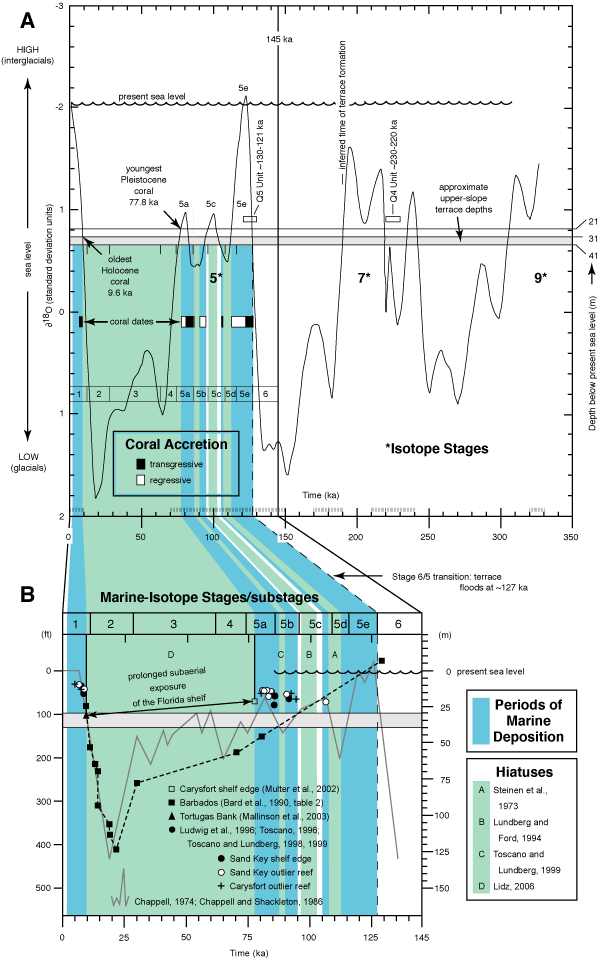FISC - St. Petersburg
Figure 37. (A) Marine oxygen-isotope paleotemperature curve of Imbrie et al. (1984) shows high and low stands of global sea level over the past 350 ka with select Florida data added. Variation in δ18O mainly reflects changes in sea level due to waxing and waning of continental ice sheets during glacial/interglacial cycles. Note periods of transgressive (black boxes representing dated-coral ages) and regressive (white boxes) coral accretion. Shaded bar represents depths (~30-40 m) of present upper-slope terrace beneath the outlier reefs, as based on actual depths (21 and 31 m) of corals with respective radiometric ages of 77.8 and 9.6 ka (Multer et al., 2002; Mallinson et al., 2003). Closely spaced tick marks at bottom represent 1-ka intervals. Q Units are marine stratigraphic sections of Perkins (1977); dates are from Multer et al. (2002) and Muhs et al. (2004). The Q3 unconformity is a prominent stratigraphic horizon and is found everywhere in south Florida. The Q4 unconformity is less evident and is more difficult to identify. Inferred time of upper-slope terrace formation (~175 ka) of Lidz et al. (2003) is revised to ~190 ka in Lidz (2006). (B) Detailed record of sea-level change during the last glacial/interglacial cycle over the past 150 ka (modified from Ludwig et al., 1996) relative to depth of the upper-slope terrace (shaded horizontal bar). Marine oxygen-isotope Stages (6-1) and Stage 5 substages (5e-5a) are periods of time that represent variations in oceanic temperatures coincident with high or low sea levels. Hiatuses represent gaps in the rock record (Fig. 7B). Hiatuses or gaps in Florida isotopic data correlate with sea-level lowstands that would likely manifest as subaerial-exposure surfaces or unconformities in the geologic record (see Fig. 5B for definitions). Gray curve was derived from dating of tectonically uplifted coral reefs on the Huon Peninsula, New Guinea, and is shown for comparison with coral-age data from Barbados (dashed line) and tectonically stable Florida (triangles, circles, and plus signs). Approximate durations of substages within Stage 5 are: 5e (127-116 ka), 5d (116-108 ka), 5c (108-96 ka), 5b (96-86 ka), and 5a (86-75 ka). The Key Largo Limestone reef (middle and upper Florida Keys) and Miami Limestone oolite units (lower Florida Keys and beneath Miami) developed during substage 5e. The largest outlier reef seaward of Sand Key Reef contains corals that date to substages 5c, 5b, and 5a and the Holocene, or Stage 1 (Ludwig et al., 1996; Toscano, 1996; Toscano and Lundberg, 1998, 1999). The horizontal line (at ~30 m below present sea level) represents the highest elevation of the present upper-slope terrace on which the outlier reefs grew (Lidz et al., 1991; Lidz et al., 2003). All datasets and coral ages point to subaerial exposure of the outer Florida shelf (for ~68 ka) and the paleoplatform interior (for >100 ka) between substage-5a time and the Holocene (Lidz, 2006; Lidz et al., 2006).
|
Can't see the printable PDF version? Get the free Adobe Acrobat® Reader. |
